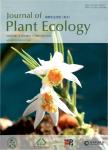Wildfire and floral herbivory alter reproduction and pollinator mutualisms of Yuccas and Yucca moths
作者机构:Department of EvolutionEcology and Organismal BiologyThe Ohio State UniversityColumbusOH 43210USA Department of Plant and Wildlife SciencesBrigham Young UniversityProvoUT 84602USA
出 版 物:《Journal of Plant Ecology》 (植物生态学报(英文版))
年 卷 期:2017年第10卷第5期
页 面:851-858页
核心收录:
学科分类:0710[理学-生物学] 090504[农学-特种经济动物饲养(含:蚕、蜂等)] 0907[农学-林学] 0905[农学-畜牧学] 09[农学] 0713[理学-生态学]
基 金:We thank Alyssa DeFranco Rachel Nettles Justin Taylor Anson Call Amy Clark and Tara Bishop for field assistance and Loreen Allphin for providing guidance.We express gratitude to the Lytle Preserve and the Bureau of Land Management for logistical support.This project was supported by the Redd Center for Western Studies fellowship.This project was funded by USDA NIFA grant:2010-38415-21908.Conflict of interest statement.None declared
主 题:cattle disturbance Mojave Desert pollination Yucca brevifolia Yucca baccata
摘 要:Aims Wildfire and ungulate herbivore pressure are increasing globally due to human activities,including arid ecosystems that are sensitive to disturbance,and are highly dependent on pollinator *** evaluated how wildfire and ungulate herbivore pressure influ-ence plant reproductive success and pollinator *** We evaluated flower production,floral herbivory,pollinator visita-tion and fruit set of two Yucca species with highly specialized polli-nator mutualisms(Yucca baccata and Yucca brevifolia)in unburned and burned landscapes created by fires that occurred in the Mojave Desert in *** Findings Yucca baccata plants in burned landscapes had a greater propor-tion of flowering individuals than plants in unburned areas(23 versus 12%).All *** individuals in burned and unburned landscapes produced ***-four percent of *** inflorescences were removed due to herbivory by cattle in burned areas,compared to 51%in unburned ***-two percent of *** inflorescences on branches≤2 m in height were removed in burned areas due to cattle herbivory compared to 39%in unburned ***,we did not observe any inflores-cence removal on *** branches2 m where the major-ity of *** inflorescences are *** moths,the only known pollinators of these two species,visited *** uniformly in burned and unburned areas but failed to visit ***-cata *** brevifolia had strong fruit production,but not a single fruit was produced among the thousands of flowering *** plants *** herbivory and the loss of obligate pollinator mutualisms appear to be critical threats to the long-term viability of *** populations in this *** reproduc-tive resilience of *** and the maintenance of its pollinator populations appear to be due to its taller stature,which allows verti-cal escape of flowers from ungulate *** of live-stock during



